Log in or create new account to save this product to your wishlist.
Iron Sulphate: What is it and how do you use it?
Give your lawn a super-boost of nutrients that transforms the colour of your grass in days. Iron sulphate kills moss and turns your grass BRIGHT green!
Latest articles
7 MIN 22 Jul How to keep your lawn in shape this summer 9 MIN 15 Jul Watering Your Garden: 10 Top Tips! 11 MIN 15 Jul Is Your Grass Type Right for your Garden? 11 MIN 10 Sep Create Your Low-Maintenance Garden – Tips and Ideas 11 MIN 08 Sep The Ultimate Guide to Choosing the Perfect Hedges for Your Garden 12 MIN 30 Aug The Top 20 Evergreen Climbers to Transform Your GardenIs your lawn looking a little tired, withered, and pale? Maybe you have spongy moss spreading across the surface of your soil? Perhaps your lawn just needs a little pick-me-up? Iron sulphate is the answer.
- What is Iron Sulfate?
- What’s the difference between iron sulphate and ferrous sulphate?
- What do you use iron sulfate for?
- Iron sulphate for scarifying
- Fighting lawn moss with iron sulphate
- How do I buy Iron Sulphate?
- How to use iron sulphate
- When to spread iron sulphate on your lawn
- Avoid walking on your lawn for seven days!
- Is Iron Sulphate Toxic or Harmful to Animals?
- When is iron sulphate not suitable for a lawn?
- The advantages of MOOWY’s iron products
Iron boosts photosynthesis, producing a lawn deep in emerald green and kills off the moss that suffocates the grass’s roots.
This article is all about increasing the resistance of your lawn with iron sulphate. We explore how to apply it, when, and how much to use. With an appropriate regime, you can maximise the natural verdancy of your lawn while preventing moss and boosting the health of your grass.
What is Iron Sulfate?
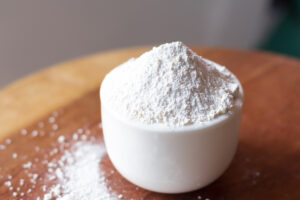
Iron is an essential element for a healthy lawn. It boosts photosynthesis (the process that turns light energy into chemical energy for nutrition). During photosynthesis, the plant extracts minerals from the soil and makes sugars with the help of solar energy, carbon dioxide, and water.
This process increases the plant’s resilience and gives it its beautiful, deep green colour. Iron helps the grass plant extract energy from sunlight, so it’s wise to feed your lawn with an iron-rich fertiliser such as Iron Plus 2-in-1 Moss Killer and Fertiliser.
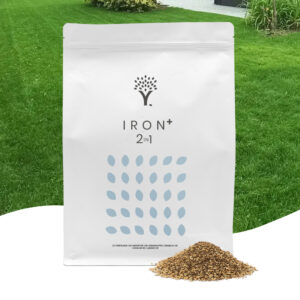
- 2-in-1: Moss killer & lawn feed in one!
- High-quality granules – not cheap powder!
- Added iron sulphate increases resistance and helps the lawn recover after the winter
Iron sulphate (aka ferrous sulphate) is often referred to as a “trace element” (meaning it contains a minimal amount of metal). It is added to general fertiliser mixes, defined by their NPK values.
Without additional help, it’s unlikely that your soil contains enough iron to maximise the growth and vitality of your lawn.
What’s the difference between iron sulphate and ferrous sulphate?
In short: nothing. It’s the same thing. Iron sulphate is often called ferrous sulphate or sulphate of iron.
Chemically, iron sulphate is a salt with various applications – industrially, horticulturally, and even medically.
You might be prescribed ferrous sulphate as a dietary supplement to treat anaemia and iron deficiency. But we absolutely do NOT recommend snorting a line of garden-bound iron sulphate, as there may be other toxic compounds included in the mix!
If you have a blood iron deficiency, speak to your doctor; not your lawn expert!
What do you use iron sulfate for?
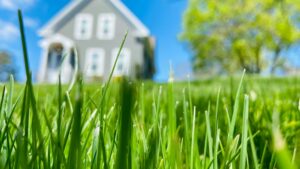
Iron sulphate has several uses and can be applied to your lawn throughout the growing season to bring energy and vitality to your lawn.
Lawn-bound products are usually supplied in powder or granulated form and are often included in general fertiliser mixes. The principal reasons for adding iron sulphate to your lawn are:
- Boosting the nutrient levels of your lawn after the winter
- Providing your lawn with a fresh, deep green glow
- Improving resilience before scarifying
- To combat moss
TIP: An accurate measure of iron sulfate kills moss in as little as four days.
Use it after winter
Your lawn has to endure a lot in the winter:
- Rain, snow, and sleet
- Low temperatures and frost
- Minimal sunlight
- Pests that burrow into the soil
- Diseases and fungi
Iron sulphate increases resistance to all of the above, making it a very welcome addition after a long, hard winter.
Use it for a green lawn
Sometimes your lawn develops a yellow or brown tinge, often during periods of drought. Adding iron sulphate will restore the natural green glow of your grass within a week of application.
Iron sulphate for scarifying
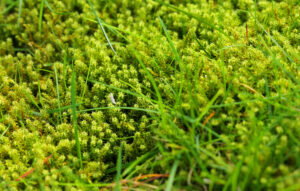
Scarifying is the act of removing the moss and organic matter that builds up on your soil’s surface. Grass needs oxygen to thrive, but the thick thatch layer around the individual grass plants eventually suffocates the roots.
So, it’s advisable to scarify your lawn every couple of years.
But:
Scarification is pretty harsh, and it initially wrecks the look of your lawn. You effectively rake the top surface of the soil away, removing the moss and dead organic matter, and it can make your lawn look very sorry for itself.
So:
Apply iron sulphate a week before you plan to scarify. This will get the plants in good shape before you attack them with the rake. The iron sulphate increases the resilience of the plants and gives them a much better chance of bouncing back after scarification.
Fighting lawn moss with iron sulphate
Moss can be a harsh opponent for your lawn, and it can appear for various reasons. It could be that:
- Your soil is too acidic
- Your soil is water-logged
- There’s too little sunlight
- Your grass has been mown too short
And while iron sulphate doesn’t remedy the CAUSE, it does clear up the moss.
Some quick fixes, though:
- If your soil is too acidic, add lime.
- For water-logged soil, aerate it.
- Gardens with very little sunlight, you might be better with a different grass type that thrives in the shade.
- If you’re mowing your grass too short? Well – just stop cutting it so short!
Iron sulphate is super-effective against moss. The right amount kills moss within just four days!
After application, the moss turns from green to yellow or brown, which means that it’s dying off. This makes it easier to remove during scarifying, helping you restore your lawn to its former glory.
However:
Iron sulphate can make your soil more acidic, which – of course – can promote new moss or weeds. So, after using iron sulphate, it’s advisable to add Lawn Lime to counteract the raised pH.
It’s a complex chemical balance, isn’t it!
How do I buy Iron Sulphate?
Well, this is where a little bit of controversy enters the conversation! You can buy iron sulphate in its pure form as a white powder. But the Royal Horticultural Society doesn’t recommend using pure iron sulphate on your lawn because it can actually blacken your grass if you add too much.
And there’s an odd legal issue with pure iron sulphate that prohibits its sale as a moss killer.
However, fertilisers with iron sulphate as its principal active ingredient (like 2-in-1 Moss Killer and Fertiliser) are fine. Make sure you follow the manufacturer’s instructions; you shouldn’t experience problems.
How to use iron sulphate
The easiest way to add iron to your lawn is to use a pre-mixed product. But if you have the pure stuff, you can mix it with sand or dissolve it in water.
Mixing with sand
Mix 2-3kg of product with 4-5kg of sand per 100m2. Spread the mixture over the lawn by hand or with a spreader.
Alternatively, use 29g per m2 if you’re using 2-in-1 Moss Killer and Fertiliser – no need to mix it with sand.
Dissolving in water
For 100m2, mix 60-250g (depending on conditions and soil pH) with 100 litres of water.
For a more manageable (and liftable) solution, use a 10-litre watering can. Fill it with water and add 6-25g (about half a cup) of iron sulphate.
Tip: Iron Sulfate can leave unsightly, brown, rusty stains. Therefore, wear old clothes and shoes.
When to spread iron sulphate on your lawn

Whenever you’re sprinkling powder or granules, it’s best to wait for a windless day; otherwise, your mix can spread into flower beds.
Iron powders stain concrete and floor tiles, so avoid contact with your patio or paths. If any dry product does make contact with paved surfaces, sweep it up before it gets wet.
Activate your product by lightly watering your lawn after applying. If there’s light rain forecast, you can wait until the shower – but avoid a day with heavy showers, as it can wash the iron sulphate away from the surface of your lawn.
You can apply iron throughout the year (avoiding June, July, and August).
Avoid walking on your lawn for seven days!
Iron powders can leave unsightly, brown or rusty-looking stains on clothes and shoes. After applying, you should see improvements in the appearance of your lawn within a couple of days, but it can still stain for up to seven days.
And, in some circumstances, standing on your grass causes a chemical reaction that leaves black footprints in the lawn.
Give your lawn time to absorb the product – at least seven days is recommended.
Is Iron Sulphate Toxic or Harmful to Animals?
Always read the instructions, but most iron-based garden products aren’t toxic or harmful to animals. Essentially, you’re applying natural minerals to your lawn, so it’s not like you’re adding harsh chemicals.
However, pets (and humans) shouldn’t eat iron sulphate, so ensure that you store your product correctly. All MOOWY products are supplied in resealable pouches, so just seal it up, and it will remain safe.
When is iron sulphate not suitable for a lawn?
You shouldn’t use iron products on a newly seeded lawn. Lawn seedlings younger than three months old are unable to absorb iron sulphate. If you sprinkle it on a young lawn, you’ll just increase the soil’s acidity, which is bad for your grass plants.
The advantages of MOOWY’s iron products
MOOWY’s 2-in-1 Moss Killer and Fertiliser comes ready-mixed, so there’s no need to dilute or mix with sand. It improves the cellular structure of your grass, increasing the resistance and helps tired winter grass recover in the spring.

- 2-in-1: Moss killer & lawn feed in one!
- High-quality granules – not cheap powder!
- Added iron sulphate increases resistance and helps the lawn recover after the winter
You’ll see a colour boost within two days of application and a total transformation within a week. This all-in-one product contains an NPK ratio of 3:7:10, with added Magnesium Oxide for strengthened cell structure.
Ready to get started?
Are you ready to improve your lawn? View our range of grass seeds, fertilizers & kits and get everything you need for a perfect lawn.
If you have any questions about this article, please email us, and we’ll be happy to help!
Leave a comment
Your answer will be displayed on the site and the interested party will be notified by email.
Leave a comment
Have a question or want to share your experience? Leave us a comment.
Read more
The best tips and tricks for a lush green lawn
 Scarifying Kit
All products after scarifying | Quickly restores the lawn after scarifying | Outsmart weeds quickly with the use of this kit
From: € 39.99
Scarifying Kit
All products after scarifying | Quickly restores the lawn after scarifying | Outsmart weeds quickly with the use of this kit
From: € 39.99
 Spring Lawn Care Kit
MOOWY’s choice for the spring | Quick recovery of your lawn after winter | A strong lawn prevents weeds
From: € 25.99
Spring Lawn Care Kit
MOOWY’s choice for the spring | Quick recovery of your lawn after winter | A strong lawn prevents weeds
From: € 25.99
 Long Lasting Lawn Fertiliser
Effective for 90 days | See results in 14 days! | Suitable for all types of grass and soil
From: € 13.99
Long Lasting Lawn Fertiliser
Effective for 90 days | See results in 14 days! | Suitable for all types of grass and soil
From: € 13.99
Do you want a lawn calendar?
🌱 All important maintenance moments for your lawn during the year. Leave your email and we will send you the lawn calendar for free.
Enter your email
Receive the lawn calendar in the mail
Enjoy a green lawn all year round!




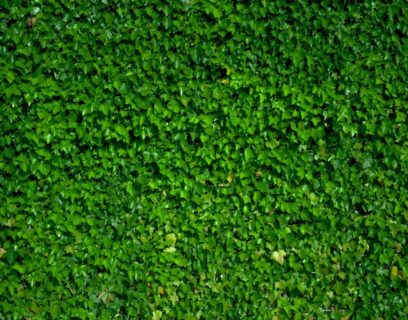
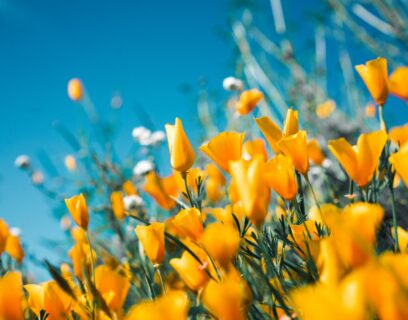
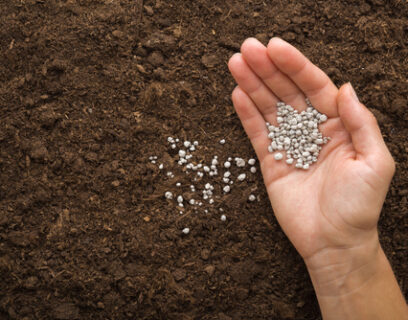






Comments (0)
There are no comments yet. Well then, what are you waiting for to
Be the first to write your comment!inaugurate this pretty page?
Do you have some comments?